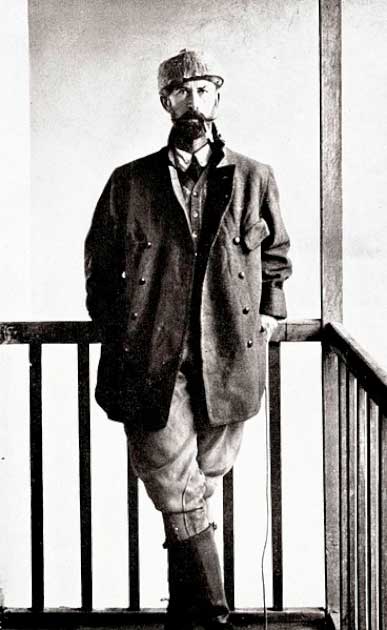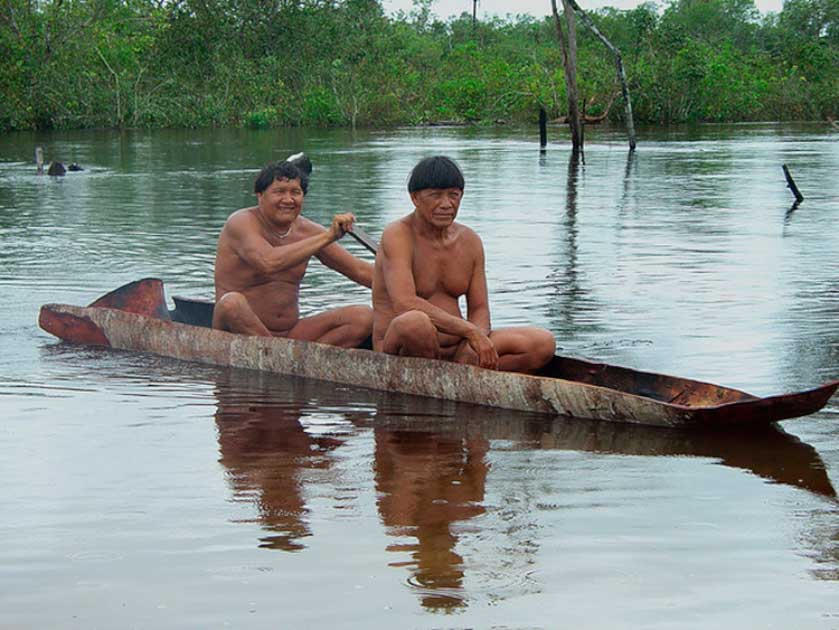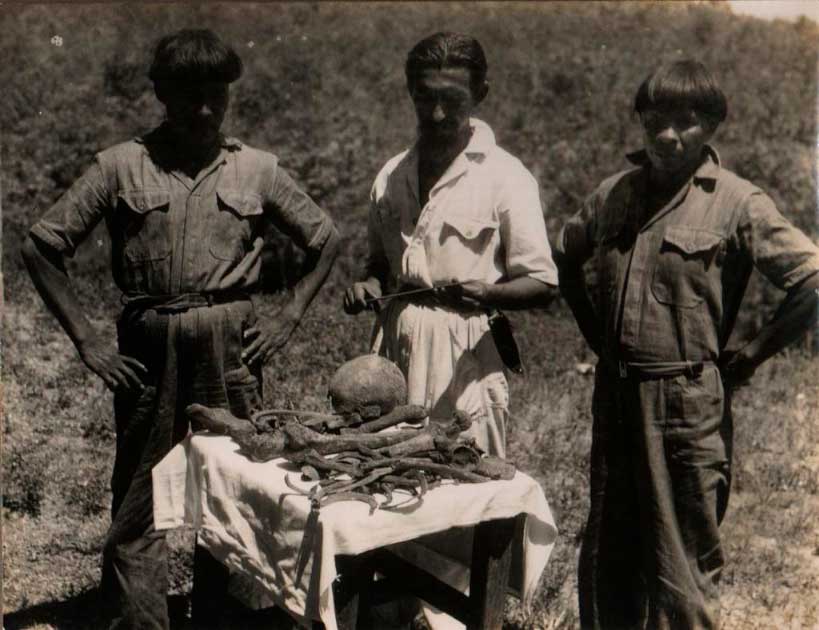Ever heard of Percy Fawcett, one of the world’s greatest explorers? Hardly a household name on the same level as Marco Polo or Christopher Columbus, but in his way he was just as important as these better known adventurers. And in his way he was as prone the exaggeration as them too.
He is remembered as a friend of the indigenous peoples in the Amazon jungle, having had a fantastic career as an anthropologist and explorer and was also, it is rumored, the inspiration for Indiana Jones. Yet, authors and movie directors are also known to take artistic licenses and remove parts of a story that are less than savory.
Was Percy Fawcett as extraordinary as he is made to seem? Or was he just an incompetent and racist man who never discovered anything, searching for his strange fantasy of a new El Dorado in the jungle?
Lieutenant-Colonel Percy Fawcett
Percy Fawcett was born on the 18th of August 1867 in the seaside town of Torquay in Devon, England. He was first a lieutenant and eventually a colonel in the Royal Artillery. He served in England’s military in Sri Lanka, Hong Kong, and Malta, fought in World War I, and was a member of the British Secret Service in Morocco.
Percy Fawcett gained the soul of an adventurer during his years in the military. Becoming a member of the Royal Geographic Society and a trained surveyor, he helped map unexplored areas of the Amazon. Percy Fawcett would make seven expeditions into the jungles of the Amazon between 1906 and 1924 in total, and six times he brought back valuable information.

During his surveying expeditions, Percy Fawcett theorized that deep in the jungle, the remains of a lost city of an advanced and civilized society lay hidden. It is thought he formulated the theory of the “lost city of Z ” due to the rediscovery of the Inca city of Machu Picchu that occurred in 1911.
In addition to this inspiration, there were rumors of a secret city in Chile with streets of silver and roofs made of gold, as well as the stories of El Dorado, the lost city of gold. According to a letter Percy Fawcett wrote to his youngest son Brian that described the lost city of Z:
“…the inhabitants used an alphabetical writing allied to many ancient European and Asian scripts. There are rumors, too, of a strange source of light in the buildings, a phenomenon that filled with terror the Indians who claimed to see it. [In the city of Z] the houses are low and windowless, and there is a pyramid temple. The inhabitants of the place are fairly numerous, they kept domestic animals, and they have well-developed mines in the surrounding hills. Not far away is a second town, but the people living in it are of an inferior order to those of ‘Z.’ ”
Percy Fawcett believed that a document from the National Library of Rio De Janeiro further supported the existence of this lost advanced city. The document Fawcett read was known as Manuscript 512, and was believed to have been written by the 18th-century Portuguese explorer João da Silva Guimarães.
In the manuscript, Guimarães describes how in 1753, he found ruins of an ancient city similar to ancient Greece. It describes a city with multi-storied buildings laden in silver, stone arches, and a temple with carvings that looked like early European or Greek.

There also was a lake where he saw two white natives in a canoe. Archeologists of the time dismissed Guimarães’ claims, and they believed that the Amazon jungle was not capable of supporting a large city or one as European sounding in nature.
Did that and the criticism Percy Fawcett received when he returned to England and shared tales of the lost city of Z quench his desire to find it? Not at all. He made many trips to Brazil to search for the lost city of Z, including the one where he mysteriously disappeared.
The Final Expedition
In 1925 Percy Fawcett went to Brazil with his eldest son Jack and Jack’s best friend Raleigh Rimell for an expedition to find the city of Z. This was the beginning of the end for Percy Fawcett. He knew how vital supplies would be for the trio, yet he insisted they pack light.
Explorers of the time knew that a person could not cut trails or sustain life in the Amazon without at least eight men to help carry supplies. Percy Fawcett believed the minimal supplies were a way to pass by native tribes without being noticed, as some tribes were known to be hostile to outsiders.
Percy Fawcett was confident that the lost city of Z existed, his experience trekking through the Amazon, the strength of his two young companions, and the unjustified belief that the natives would help and look after them. Before they left, Fawcett instructed that should they not return from their expedition, not to embark on a rescue mission because they would likely die too.
The last time Fawcett communicated to his wife, on 29 May 1925, he wrote, “Jack is well and fit and getting stronger every day. You need have no fear of any failure”. Nothing about that letter was true. The men were never heard from again.
When the men failed to return by 1927, a rescue mission was organized by the Royal Geographic Society. But after finding nothing, they were forced to conclude that the men were likely dead. Rumors of what happened to Percy Fawcett began to spread like wildfire, and his disappearance became the subject of news reports for years.
In the absence of any evidence as to what had happened, the stories became wild. Some tales posited that Fawcett “went native” and was living in the jungle. Others said he had gone to Brazil to form a cult, he was being held prisoner, and he might have become the chief of a tribe of cannibals.
The Kalapalo tribe were believed to have been the last people to see the men, and members of the tribe would tell rescuers different things. The chief, Ixarari, said he killed the men because Jack Fawcett impregnated a local girl.
According to this story, their bodies were then left along the bank of the Tanguro River to be scavenged by animals. Finally only bones remained to be disposed of. But the tribe had also told others they had nothing to do with Percy Fawcett’s disappearance or death. While they did admit they saw the men and mentioned that they could see smoke from the men’s fire for five days until it disappeared.

With this new version of the story, they reasoned another tribe had killed the men. In 1951 an activist from Brazil even came forward with a skeleton he claimed was Fawcett, but DNA analysis and testing proved that the bones were not Percy’s.
The Real Percy Fawcett
Percy Fawcett was recently the subject of the 2017 film The Lost City of Z. He is portrayed as a great explorer, friend to the natives, and skilled in survival. However, this depiction of Percy Fawcett is anything but accurate.
The real Fawcett was a fan of publicity, inexperienced, and thoroughly racist. The well-known Amazon historian John Hemming sheds the false image of Fawcett in a book he wrote in 2003. Hemming documented Fawcett’s “ugly racist notions about the Native Americans.”
- The Lost City of Thinis: Where is the First Capital of Ancient Egypt?
- Brazilian Mystery Ditches: Man-made and Older than the Jungle?
Percy described the natives he saw in letters and interviews as “large, hairy men, with exceptionally long arms, with foreheads sloping back from pronounced eyes…villainous savages, hideous ape men with pig-like eyes.” He felt that the tribespeople were so unsophisticated that they looked like Neanderthals, which is inaccurate.
More proof of Percy Fawcett’s racist beliefs comes from his writings, stating that “there are three kinds of Indians. The first are docile and miserable people, easily tamed; the second, dangerous, repulsive cannibals very rarely seen; the third, a robust and fair people, who must have a civilized origin.” Percey Fawcett believed that it was the third type of “civilized Indians” who had created and lived in Z, because all other tribes were too primitive to build such grand structures.
Percy’s death could have come from any one of his many poor choices in his final expedition. Three men are not enough people to carry the supplies the expedition needed to survive. Starvation or dying due to lack of resources is a possibility. His choice to take only his son and his son’s best friend was another poor choice.

The two boys were inexperienced and unprepared to keep up with Percy’s reported fast pace that spanned 10 to 15 miles (16 to 24 km) daily. The boys were said to be struggling, and Jack’s friend was said to have an infection in one of his legs from a tick bite which would have slowed him down. There is a possibility natives killed the men, but the terrain would have left them in deep trouble in any case.
The area was known to have several hostile indigenous tribes who would attack strangers. Several tribes were however known to be hospitable. Percy Fawcett’s assumption that all the tribes he would encounter would be friendly and help the men may have been a fatal mistake.
Then and now, those exploring the Amazon would bring gifts to give to the leader of any tribe they encountered. This is an unwritten rule but is seen by the natives as a sign of respect, and in return, some tribes would give explorers things like food, water, etc.
Percy Fawcett packed light with little supplies, including gifts for the natives. Yet his racism and ignorance gave him the impression that the Indians would help him without Fawcett giving them anything in return, which was not a wise move.
Along with being blinded by racism and his ideas about natives, it was reported that he refused to share a duck he shot with the indigenous guides he had on the first leg of the trip. He also once hit a child for playing with his knife.
Hemming, who has studied and interacted with over 40 indigenous Amazonian tribes, wrote in his book, “Striking an Indian in anger is a deep insult. The [Xingu] Indians are infuriated by any aggression against a child, since they are deeply affectionate parents…And native hunters invariably share out their game.”
Another foolish decision Percy Fawcett made was his refusal to say exactly where it was that he would be going. He had told his wife that they intended to stop at a camp he had previously made on a past trip, yet the report to the American press placed the camp at a different location.
The two different coordinates and his demand that a search party not be set should they not return was odd. Why he did this is unknown, but some believe that these actions may have been an attempt to prevent anyone else from finding Z, even those sent to rescue him.
To this day, the three men, as well as Z, have not been found. What happened on that final expedition will always be shrouded in mystery.
Top Image: Did Percy Fawcett find the Lost City of Z on his final expedition, or is there a more prosaic explanation for his disappearance? Source: Trafa / Adobe Stock.
By Lauren Dillon